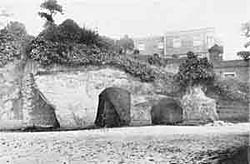< Previous | Contents | Next >
Rock Holes, The Hermitage, Castle-Boulevard
 |
THE caves of Nottingham are one of the most difficult and intricate problems of local archaeology. Some of them are natural; others are artificial, but date back to prehistoric times, others again are mediaeval or even modern cellars.
At any rate, there are so many of them that they become almost a nuisance, for wherever the builder goes in the centre of the town it is difficult to find sure foundations because of them.
They have always been famous, and Asser, the friend and biographer of King Alfred, writing about 900, tells us that the ancient name for Nottingham was Tiuogobauc, which he translates as meaning " the cave dwellings."
The particular caves shown in this picture have always excited interest, and they have been assigned to all sorts of ages and to all sorts of uses. What is really known about them is that throughout the Middle Ages they are spoken of as The Chapel of St. Mary in the Rocks,’’ and that in Norman times they were the place of residence of a body of religious people who were so important and so firmly established that when Peveril diverted the course of the Leen so as to bring it along the foot of the cliff of Nottingham Park, he was obliged to twist its course so as not to disturb these hermits!
During the eighteenth and early nineteenth centuries the caves were put to a variety of uses, largely convivial, and many stories are told of junketings held beneath their roofs.
